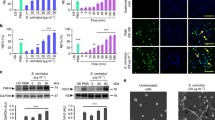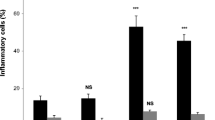Abstract
The inflammatory action of jararhagin, a hemorrhagic metalloproteinase from Bothrops jararaca venom, was studied in mice using dorsal air pouches. The injection of the toxin in 6-day-old air pouches resulted in a leukocyte accumulation comparable to that induced by LPS and whole venom. Polymorphonuclear and mononuclear cells were present in this infiltrate, with a predominance of neutrophils. Treatment of jararhagin with 1,10-phenantroline abolished its proteolytic activity and reduced the pro-inflammatory effect in approximately 50%. Cell influx was not observed when jararhagin was injected into 1-hr air pouches devoid of macrophages, except when it was injected together with 106 syngeneic peritoneal macrophages. Supernatants of macrophages stimulated in vitro with jararhagin did not induce leukocyte influx in 1-hr air pouches; the influx occurred after injection of the pellets of stimulated cultures. In summary, jararhagin is an important pro-inflammatory component of B. jararaca venom, and its activity is dependent upon the proteolytic activity and the presence of macrophages.
Similar content being viewed by others
REFERENCES
Rosenfeld, G. 1971. Symptomatology, pathology and treatment of snake bites in South America. Venomous animals and their venoms. Vol. 2, pp. 345–362 (W. Bucherl and E. E. Buckley, eds.). New York: Academic Press.
Farsky, S. H. P., J. W. M. Costa-Cruz, Y. Cury, and C. F. P. Teixeira. 1997. Leukocyte response induced by Bothrops jararaca venom: In vivo and in vitro studies. Toxicon 35:185–193.
Trebien, H. A. and J. B. Calixto. 1989 Pharmological evaluation of rat paw edema induced by bothrops jararaca venom. Agent Action 26: 292-300.
teixeira, C. F. P., Y. Cury, and S. N. Jancar. 1994. hyperalgesia induced by bothrops jararaca venom in rats: Role of eicosanoids and platelet activating factor (PAF). toxicon. 32 419-424.
Paine, M. J. I., H. P. Desmond, R. D. G. Theakston, and J. M. Crampton. 1992. Purification, cloning, and molecular characterization of a high molecular weight hemorrhagic metalloproteinase, jararhagin, from Bothrops jararaca venom. J. Biol. Chem. 267:22869–22876.
Matsui, T., Y. Fujimura, and K. Titani. 2000. Snake venom proteases affecting hemostasis and thrombosis. Biochimica et Biophysica Acta 1477:146–156.
Kamiguti, A. S., C. R. M. Hay, R. D. G. Theakston, and M. Zuzel. 1996. Insights into the mechanism of haemorrhage caused by snake venom metalloproteinases. Toxicon. 34:627–642.
Moura-da-Silva, A. M., C. Marcinkiewicz, M. Marcinkiewicz, and S. Niewiarowski. 2001. Selective recognition of α2α1 integrin by jararhagin, a metalloproteinase ?disintegrin from Bothrops jararaca venom. Thromb. Res. 102:153–159.
Blobel, C. P. 1997. Metalloprotease-disintegrins: Links to cell adhesion and cleavage of TNF alpha and Notch. Cell 90:589–592.
Black, R. A., C. T. Rauch, C. J. Kozlosky, J. J. Peschon, J. L. Slack, M. F. Wolfson, B. J. Castner, K. L. Stocking, P. Reddy, S. Srinivasan, N. Nelson, N. Boiani, K. A. Schooley, M. hart, R. Davis, J. N. Fitzner, R. S. Johnson, R. J. Paxton, C. J. March, and D. P. Cerreti. 1997. A metalloproteinase disintegrin that releases tumour-necrosis factor-a from cells. Nature 385:729–733.
Moura-da-Silva, A. M., G. D. Laing, M. J. I. Paine, J. M. T. J. Dennison, V. Politi, J. M. Crampton, and R. D. G. Theakston. 1996. Processing of pro-tumor necrosis factor-a by venom metalloproteinases: A hypothesis explaining local tissue damage following snake bite. Eur. J. Immunol. 26:2000–2005.
Ahluwalia, A. and M. Perreti. 1996. Involvement of bradikinin b1 receptors in the polymorphonuclear leukocyte accumulation induced by IL-1b in vivo in the mouse. J. Immunol. 156:269–274.
Rucavado, A., J. Nunez, and J. M. Gutierrez. 1998. Blister formation and skin damage induced by BaP1, a hemorrhagic metalloproteinase from the venom of the snake Bothrops asper. Int. J. Exp. Pathol. 79:245–254.
Clissa, P. B., G. D. Laing, R. D. G. Theakston, I. Mota, M. J. Taylor, and A. M. Moura-da-Silva. 2001. The effect of jararhagin, a metalloproteinase isolated from Bothrops jararaca snake venom, on pro-inflammatory cytokines released by peritoneal adherent cells. Toxicon. 39:1567–1573.
Hogaboam, C. M., M. L. Steinhauser, S. W. Chensue, and S. L. Kunkel. 1998. Novel roles for chemokines and fibroblasts in interstitial fibrosis. Kidney Int. 54:2152–2159.
Dayer, J. M., S. Ricard-Blum, M. T. Kaufmann, and D. Herbage. 1986. Type IX collagen is a potent inducer of PGE2 and interleukin-1 production by human monocyte macrophages. FEBS Lett. 198:208–212.
Sedgwick, A. D., Y. M. Sin, J. C. W. Edwards, and D. A. Willaoughby. 1983. Increased inflammatory reactivity in newly formed lining tissue. J. Pathol. 141:483–495.
Author information
Authors and Affiliations
Rights and permissions
About this article
Cite this article
Costa, E.P., Clissa, P.B., Teixeira, C.F.P. et al. Importance of Metalloproteinases and Macrophages in Viper Snake Envenomation–Induced Local Inflammation. Inflammation 26, 13–17 (2002). https://doi.org/10.1023/A:1014465611487
Issue Date:
DOI: https://doi.org/10.1023/A:1014465611487




